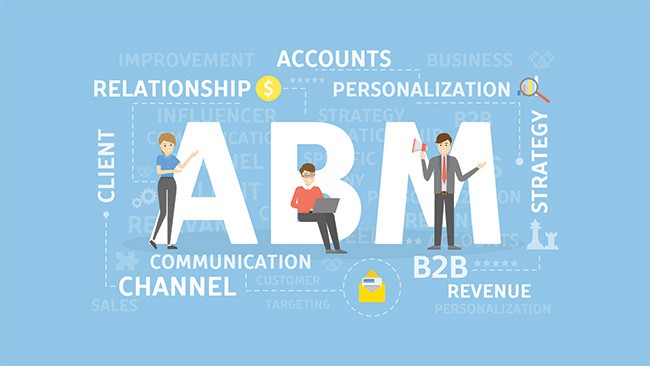Account-Based Marketing is a way to improve customer experience. It has three main components: strong alignment between sales and marketing, an efficient and optimized marketing & sales funnel, and better customer experiences. When Account-Based Marketing campaigns are executed well, they can increase ROI by as much as 300%.
According to SiriusDecisions, 92% of B2B marketers consider ABM “extremely” or “very” important to their marketing efforts, and despite the constraints brought by the pandemic, over 40% of B2B marketers experienced no change to their ABM budgets.
In this blog post, we’ll explore how account-based marketing drives excellent customer experiences through these fundamental principles of ABM.
What is Account-Based Marketing?
Account-based marketing is a digital customer experience management method that focuses on targeting key accounts for personalized outreach and lead generation. This process often includes generating lists (called “target account profiles”) with detailed information about prospects and understanding their needs, goals, interests and behaviours so marketers can develop tailored content accordingly.
This strategy has three main components: strong alignment between sales and marketing to ensure there are aligned expectations; an efficient and optimized marketing & sales funnel which allows both teams to work smarter by eliminating inefficiencies; better customer experiences which come from more relevant messaging sent at the right time through channels your target audience uses most frequently.
Account-Based Marketing vs Inbound Marketing
Account-based marketing (ABM) can be seen as an extension of inbound marketing. Inbound marketing is primarily about content creation and distribution. ABM, however, includes many other components such as customer profiling and account intelligence gathering. Segmentation strategy development is also included. Personalized outreach campaigns are created to meet prospects’ needs at every stage of the buyer’s journey.
Account-based marketing is also known by some marketers who feel like it has become too focused on “account” rather than providing value or sales support to any given company that they work with as “targeted outbound” (rather than “inbound”).
The difference between these two approaches boils down to how much time and effort a company is willing to put into each strategy. Account-based marketing may require more resources upfront, but the return on investment can be significant – as much as three times higher than for those relying solely on inbound approaches.
That being said, if time or budget constraints make implementing both strategies impossible, then inbound should always come before outbound. Ideally, both of them should be a part of your digital marketing strategy.
How To Run An Account-Based Marketing Campaign?
There are three main components to running account-based marketing programs. The first is selecting which accounts you want to target with a high probability of buying your company. The second involves developing and optimizing channels for targeted messaging with the right content. The third involves aligning both sales and marketing teams, so they’re working together. Below we will dive into each in more detail:
Selecting Your Target Accounts
Target account selection is the process of developing a list (called “target account profiles”) with detailed information about prospects, as well as understanding their needs, goals, interests and behaviours. It starts by reviewing sales data to identify accounts that are most likely to buy your product or service in the near future.
There are two primary approaches to target account selection:
Top-down approach – this is when you start with a high-level list of all the accounts within your organization and then work down to identify those most likely to buy soon; or,
Bottom-up approach – starts with identifying which industries/segments are your best opportunities and then determines the accounts in those industries/segments that have a high probability of buying.
Aligning with Sales & Developing Follow-up SLAs
For ABM to be successful, both marketing and sales reps need to work together. This means aligning on which accounts they’re targeting and how customer follow-ups will occur.
For this to happen, marketing needs access to the sales pipeline to align content with what’s currently happening in the account (regardless of whether it’s a BSA, MQL, or other). Marketing also needs enough time when an opportunity is won/lost to create the right content and follow-ups.
To help your marketing team set up a system for managing sales pipeline data, we recommend creating lead records with the account information (including contact info). Then assigning those leads to specific channels where teams across different departments can track them. These channels should include all of your ABM efforts.
Better Customer Experiences
Account-based marketing is not just about generating leads with funnel tactics. It’s a strategy that integrates all aspects of your digital customer experience, from the first contact with prospects (also called touchpoints) to relationship building.
The account-based marketing funnel is a customized, consumer-focused sales and marketing process where prospects are targeted with messages based on their stage in the buyer’s journey and what content they have engaged with or clicked on to learn more about your product/service.
Return On Investment Of Account-Based Marketing
One of the significant benefits of ABM is that it provides a higher return on investment than inbound marketing. Studies show that companies with an account-based approach can expect a 300% ROI instead of 100%. The main reason for this is that ABM leads to more opportunities and pipeline growth when done correctly. ABM can help you realize a much higher revenue potential.
The ROI of an account-based marketing strategy is typically much better than other forms of digital customer experience management because it can leverage target account intelligence from sales process data, ensuring that your messages are even more relevant to prospective customers.
The best way to measure success with account-based marketing is through your return on investment. It’s vital that you measure progress, not just in terms of leads generated but also revenue generation. A standard method for calculating ROI involves dividing lead volume by cost. For example, if you used $100,000 worth of advertising over three months and created 500 new qualified sales opportunities, your ROI would be 100%.
Planning, Implementing and Optimizing your ABM Program
The first step in an account-based marketing campaign is to identify your target accounts. The more accurately you can define these customers, the better – everything from their size and industry to what they’re interested in reading about should be taken into consideration.
Once a company has identified its targets (accounts), it must then figure out how best to engage with them on social media channels like LinkedIn or Facebook.
Many different approaches can work depending on whom you’re targeting and how much time/resources you have available; one example would be publishing blog posts related to topics of interest for potential buyers at each stage of the buying process. Another approach might involve hosting webinars covering specific product features during peak times when the target account is active on social media.
Regardless of which method you choose, it’s essential to use specific data about your customers during this stage so that you can craft personalized content that’s relevant to them and will be compelling enough for them to click through or register for more information.
Now that we’ve covered some of the basics, it’s time to get into how account-based marketing campaigns are implemented.
It turns out there are many different ways you can go about this – for example; one company might choose to send emails directly from its sales team while another may prefer to focus on content and social media channels instead. The approach taken will depend primarily on both what type of accounts you’re targeting and your budget available at any given point in time.
There are many ways companies can optimize their ABM efforts after a campaign is completed. These include refining targeting strategies using insights from platforms like Google Analytics to re-evaluating the type of content they require at each stage of a purchase process (for instance, creating educational blog posts for prospects who want product specifications). Some organizations successfully use a feedback loop that includes ABM analytics reports and customer insights to refine the campaign.
Examples Of Successful Accounts-Based Marketing Campaigns
There are many examples of successful account-based marketing campaigns.
One example of a successful ABM in the food industry is Chefler, which provides fresh-made meals and snacks to offices. They found that their target ideal customer profile was often someone who had an office job with little or no time for cooking dinner after work – they also used data from social media channels like LinkedIn to identify other companies where this might be happening and targeted them as well.
This strategy enabled the company to increase its sales by over 100% while still managing costs. It only focused on targeting customers at the right stage in their decision process (prospects) instead of wasting money trying to get people interested who were not ready yet.
Another great example comes from InvoCare, Australia’s largest home care provider. The company struggled to compete with the big-name players in the industry and needed a new strategy for generating leads. InvoCare’s account-based marketing campaign started by identifying their target customer: someone aged 65 or over who lives alone or has experienced a medical event that means they need care from time to time.
They then created an advertising plan based on what content prospects at this stage of decision making are interested in (in this case, it might be information about how much help is available). They also had success targeting companies whose employees have similar jobs as those people identified earlier – these workers can find themselves in situations where they may need home care assistance one day too.
By following best practices like these, InvoCare increased its lead volume by over 300% and grew the number of qualified leads for sale from 18 per month to 100+ in just four months.
ABM can be used for many different purposes – from generating leads to building brand awareness or increasing product engagement among prospects. However, one of its most effective uses is helping companies identify new customers at an earlier stage than they would have otherwise been able to. By doing this, you’ll increase your lead volume and make sure that each account has a higher lifetime value potential. That way, when it comes time for renewal, there will be less pressure on sales teams who are trying their hardest to close deals while simultaneously handling all those other responsibilities!
Conclusion
As you can see, account-based marketing is an excellent way to drive customer experiences. If you want help with implementing these principles in your company or want someone to bounce ideas off about how ABM could improve the customer experience for your business, feel free to shoot us a comment below! We’d love to hear from you and are always happy to share our knowledge so that we can all make more intelligent decisions when it comes down to improving customer service at any level.



